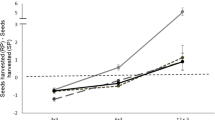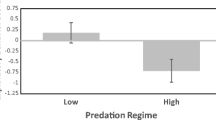Abstract
Animals can reduce their uncertainty of predation risk by gathering new information via exploration behaviour. However, a decision to explore may also be costly due to increased predator exposure. Here, we found contextual effects of predation risk on the exploratory activity of Trinidadian guppies Poecilia reticulata in a novel environment. First, guppies were exposed to a 3-day period of either high or low background predation risk in the form of repeated exposure to either injured conspecific cues (i.e. alarm cues) or control water, respectively. A day later, guppies were moved into a testing arena with limited visual information due to structural barriers and were then presented with an acute chemical stimulus, either alarm cues (a known and reliable indicator of risk), a novel odour (an ambiguous cue), or control water. In the presence of control water, guppies from high and low background risk showed a similar willingness to explore the arena. However, high-risk individuals significantly reduced their spatial evenness, although not their movement latency, in the presence of both the alarm and novel cues. When these high-risk individuals were a member of a shoal, they became willing to explore the environment more evenly in the presence of alarm cues while remaining cautious toward the novel cue, indicating an effect of the greater uncertainty associated with the novel cue. In contrast, low-risk guppies showed a willingness to explore the arena regardless of acute threat or social context. Such contextual effects of background risk and social context highlight the complexity of exploratory decisions when uncertain.



Similar content being viewed by others
Data availability
Data are provided as supplementary information.
References
Archard GA, Braithwaite V (2010) The importance of wild populations in studies of animal temperament. J Zool 281:149–160
Archard GA, Braithwaite V (2011) Increased exposure to predators increases both exploration and activity level in Brachyrhaphis episcopi. J Fish Biol 78:593–601
Berdahl A, Torney CJ, Ioannou CC, Faria JJ, Couzin ID (2013) Emergent sensing of complex environments by mobile animal groups. Science 339:574–576
Brown GE, Godin JGJ (1999) Chemical alarm signals in wild Trinidadian guppies (Poecilia reticulata). Can J Zool 77:562–570
Brown C, Jones F, Braithwaite V (2005) In situ examination of boldness–shyness traits in the tropical poeciliid, Brachyraphis episcopi. Anim Behav 70:1003–1009
Brown GE, Macnaughton CJ, Elvidge CK, Ramnarine I, Godin JGJ (2009) Provenance and threat-sensitive predator avoidance patterns in wild-caught Trinidadian guppies. Behav Ecol Sociobiol 63:699–706
Brown GE, Elvidge CK, Macnaughton CJ, Ramnarine I, Godin JGJ (2010) Cross-population responses to conspecific chemical alarm cues in wild Trinidadian guppies, Poecilia reticulata: evidence for local conservation of cue production. Can J Zool 88:139–147
Brown GE, Ferrari MC, Elvidge CK, Ramnarine I, Chivers DP (2013) Phenotypically plastic neophobia: a response to variable predation risk. Proc Roy Soc B 280:20122712
Crane AL, Ferrari MCO (2017) Patterns of predator neophobia: a meta-analytic review. Proc Roy Soc B 284:20170583
Crane AL, Brown GE, Chivers DP, Ferrari MCO (2020a) An ecological framework of neophobia: from cells to organisms to populations. Biol Rev 95:218–231
Crane AL, Feyten LE, Ramnarine IW, Brown GE (2020b) The propensity for re-triggered predation fear in a prey fish. Sci Rep 10:1–8
Dall SR (2010) Managing risk: the perils of uncertainty. In: Westneat DF, Fox CW (eds) Evolutionary behavioral ecology. Oxford University Press, New York, pp 194–206
Deacon AE, Jones FA, Magurran AE (2018) Gradients in predation risk in a tropical river system. Curr Zool 64:213–221
Elvidge C, Macnaughton C, Brown G (2013) Sensory complementation and antipredator behavioural compensation in acid-impacted juvenile Atlantic salmon. Oecologia 172:69–78
Elvidge CK, Ramnarine I, Brown GE (2014) Compensatory foraging in Trinidadian guppies: effects of acute and chronic predation threats. Curr Zool 60:323–332
Elvidge CK, Chuard PJ, Brown GE (2016) Local predation risk shapes spatial and foraging neophobia patterns in Trinidadian guppies. Curr Zool 62:457–462
Endler J (1986) Defense against predators. In: Feder ME, Lauder GV (eds) Predator-prey relationships: perspectives and approaches from the study of lower vertebrates. University of Chicago Press, Chicago, pp 169–202
Ferrari MCO, Sih A, Chivers DP (2009) The paradox of risk allocation: a review and prospectus. Anim Behav 78:579–585
Ferrari MCO, Wisenden BD, Chivers DP (2010) Chemical ecology of predator-prey interactions in aquatic ecosystems: a review and prospectus. Can J Zool 88:698–724
Feyten LEA, Crane AL, Ramnarine I, Brown GE (in press) Predation risk shapes the use of conflicting personal risk and social social information in guppies
Godin J-G (1995) Predation risk and alternative mating tactics in male Trinidadian guppies (Poecilia reticulata). Oecologia 103:224–229
Goldman JA, Feyten LE, Ramnarine IW, Brown GE (2020) Sender and receiver experience alters the response of fish to disturbance cues. Curr Zool 66:255–261
Goldman JA, Crane AL, Feyten LEA, Collins E, Brown GE (in press) Disturbance cue communication is shaped by emitter diet and receiver background risk in Trinidadian guppies. Curr Zool
Hartman EJ, Abrahams MV (2000) Sensory compensation and the detection of predators: the interaction between chemical and visual information. Proc Roy Soc B 267:571–575
Hasenjager MJ, Dugatkin LA (2017) Fear of predation shapes social network structure and the acquisition of foraging information in guppy shoals. Proc Roy Soc B 284:20172020
Hills JM, Thomason JC, Davis H, Köhler J, Millett E (2000) Exploratory behaviour of barnacle larvae in field conditions. Biofouling 16:171–179
Johnson DD, Blumstein DT, Fowler JH, Haselton MG (2013) The evolution of error: error management, cognitive constraints, and adaptive decision-making biases. Trends Ecol Evol 28:474–481
Kelley JL, Phillips SC, Evans JP (2013) Individual consistency in exploratory behaviour and mating tactics in male guppies. Naturwissenschaften 100:965–974
Krause J, Godin J-GJ (1995) Predator preferences for attacking particular prey group sizes: consequences for predator hunting success and prey predation risk. Anim Behav 50:465–473
Leduc A, Kim JW, Macnaughton CJ, Brown GE (2010) Sensory complement model helps to predict diel alarm response patterns in juvenile Atlantic salmon (Salmo salar) under natural conditions. Can J Zool 88:398–403
Lima SL, Bednekoff PA (1999) Temporal variation in danger drives antipredator behavior: the predation risk allocation hypothesis. Am Nat 153:649–659
Lima SL, Dill LM (1990) Behavioral decision made under the risk of predation - a review and prospectus. Can J Zool 68:619–640
Magurran AE, Seghers BH (1990a) Population differences in predator recognition and attack cone avoidance in the guppy Poecilia reticulata. Anim Behav 40:443–452
Magurran AE, Seghers BH (1990b) Risk sensitive courtship in the guppy (Poecilia reticulata). Behaviour 112:194–201
Mathis A, Crane AL (2017) Chemoreception. In: Call J (ed) APA handbook of comparative psychology, vol 2. APA Books, Washington, pp 69–87
Mettke-Hofmann C (2017) Neophobia. In: Vonk J, Shackelford T (eds) Encyclopedia of animal cognition and behavior. Springer International Publishing, Cham, pp 1–8
Money DA, Ingley SJ, Johnson JB (2017) Divergent predation environment between two sister species of livebearing fishes (Cyprinodontiformes: Poeciliidae) predicts boldness, activity, and exploration behavior. Rev Biol Trop 65:267–277
Munoz NE, Blumstein DT (2012) Multisensory perception in uncertain environments. Behav Ecol 23:457–462
Newar SL, Careau V (2018) The fast and the curious: locomotor performance and exploratory behaviour in eastern chipmunks. Behav Ecol Sociobiol 72:27. https://doi.org/10.1007/s00265-018-2445-2
Nordell SE (1998) The response of female guppies, Poecilia reticulata, to chemical stimuli from injured conspecifics. Environ Biol Fishes 51:331–338
Preisser EL, Bolnick DI (2008) When predators don’t eat their prey: nonconsumptive predator effects on prey dynamics. Ecology 89:2414–2415
Reader SM, Kendal JR, Laland KN (2003) Social learning of foraging sites and escape routes in wild Trinidadian guppies. Anim Behav 66:729–739
Réale D, Reader SM, Sol D, McDougall PT, Dingemanse NJ (2007) Integrating animal temperament within ecology and evolution. Biol Rev 82:291–318
Rojas-Ferrer I, Thompson MJ, Morand-Ferron J (2020) Is exploration a metric for information gathering? Attraction to novelty and plasticity in black-capped chickadees. Ethology 126:383–392
Salena MG, Turko AJ, Singh A, Pathak A, Hughes E, Brown C, Balshine S (2021) Understanding fish cognition: a review and appraisal of current practices. Anim Cogn 24:395–406
Seghers BH (1974) Schooling behavior in the guppy (Poecilia reticulata): an evolutionary response to predation. Evolution 28:486–489
Sih A (1992) Prey uncertainty and the balancing of antipredator and feeding needs. Am Nat 139:1052–1069
Swaney W, Kendal J, Capon H, Brown C, Laland KN (2001) Familiarity facilitates social learning of foraging behaviour in the guppy. Anim Behav 62:591–598
Trimmer PC, Houston AI, Marshall JA, Mendl MT, Paul ES, McNamara JM (2011) Decision-making under uncertainty: biases and Bayesians. Anim Cogn 14:465–476
Wade AS, Ramnarine IW, Ioannou CC (2020) The effect of group size on the speed of decision making depends on compromise and predation risk across populations in the guppy Poecilia reticulata. Behaviour 1:1–20
Wang Y, Fu S-J, Fu C (2019) Behavioral adjustments to prior predation experience and food deprivation of a common cyprinid fish species vary between singletons and a group. PeerJ 7:e7236
Ward AJ, Herbert-Read JE, Sumpter DJ, Krause J (2011) Fast and accurate decisions through collective vigilance in fish shoals. P Nat Acad Sci 108:2312–2315
Wilson AD et al (2014) Dynamic social networks in guppies (Poecilia reticulata). Behav Ecol Sociobiol 68:915–925
Wirsing AJ, Heithaus MR, Brown JS, Kotler BP, Schmitz OJ (2020) The context dependence of non-consumptive predator effects. Ecol Lett 24:113–129
Zanette LY, Clinchy M (2017) Predator-prey interactions: integrating fear effects. In: Call J (ed) APA handbook of comparative psychology, vol 1. APA Books, Washington D.C., pp 815–831
Acknowledgements
We thank Kharran Deonarinesingh for assistance in the laboratory.
Funding
Funding for this work was provided by the Natural Sciences and Engineering Research Council of Canada in the form of a Discovery Grant to GEB and as NSERC PGS-D to EED.
Author information
Authors and Affiliations
Contributions
EED, IWR, and GEB conceived the study. EED and LEAF collected the data. GEB and ALC conducted the analyses, and ALC wrote the first draft of the manuscript. All authors contributed to the final version of the manuscript.
Corresponding author
Ethics declarations
Conflict of interest
We declare no conflicts of interest.
Ethical approval
This research was approved by Concordia University’s Animal Research Ethics Board (protocol #30000255).
Additional information
Publisher's Note
Springer Nature remains neutral with regard to jurisdictional claims in published maps and institutional affiliations.
Supplementary Information
Below is the link to the electronic supplementary material.
Rights and permissions
About this article
Cite this article
Crane, A.L., Demers, E.E., Feyten, L.E.A. et al. Exploratory decisions of Trinidadian guppies when uncertain about predation risk. Anim Cogn 25, 581–587 (2022). https://doi.org/10.1007/s10071-021-01575-4
Received:
Revised:
Accepted:
Published:
Issue Date:
DOI: https://doi.org/10.1007/s10071-021-01575-4




